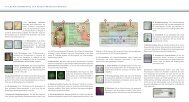Download (PDF, 589 KB, Datei ist nicht barrierefrei
Download (PDF, 589 KB, Datei ist nicht barrierefrei
Download (PDF, 589 KB, Datei ist nicht barrierefrei
You also want an ePaper? Increase the reach of your titles
YUMPU automatically turns print PDFs into web optimized ePapers that Google loves.
IDEntIFICAtIon FunCtIon IDEntIFICAtIon FunCtIon<br />
1. The new identity card – secure,<br />
standardized proof of identity<br />
in the digital world<br />
starting november 1 st , 2010, the new identity card will be<br />
introduced in Germany as an electronic, multi-functional<br />
card in credit-card format, valid as a travel document and as<br />
proof of identity both personally and in the electronic world.<br />
this identity card implements an innovative concept based<br />
on a contactless interface that is already in use for electronic<br />
passports world-wide.<br />
the new identity card not only represents a modern<br />
sovereign document that will significantly improve the<br />
identification of persons e.g. when crossing borders. the<br />
ID card will also be equipped with additional electronic<br />
functions, in par ticular electronic ID (eID) and the optional<br />
Qualified Electronic signature (QEs), which offer users<br />
significant advantages. these functionalities enable individuals<br />
to positively identify themselves online and issue<br />
legally binding electronic declarations of will. they are thus<br />
a key instrument for enabling legally valid contacts to be<br />
con cluded over the Internet, and are intended to promote<br />
streamlined eGovernment and eBusiness services.<br />
the introduction of the identification function of the new<br />
identity card entailed preparing, developing and deploying<br />
a soph<strong>ist</strong>icated It infrastructure and embedding it in a complex<br />
overall system with more than 60 million participating<br />
individuals. this required firstly that the associated organizational,<br />
legal and technical prerequisites be created. the<br />
German ID Card Act [PAuswG 2010] sets out the general legal<br />
framework for identity documentation and electronic proof<br />
of identity; the corresponding regulation [PAuswV 2010]<br />
defines in particular the requirements for security and data<br />
protection of the eID infrastructure. these are augmented<br />
by close to 20 technical Guidelines and protection profiles<br />
promulgated by the Federal office for Information security<br />
(BsI), which are published in binding form in the German<br />
Federal Gazette. some of these requirements are explained<br />
as examples in this brochure.<br />
the infrastructure of the new identity card is intended to<br />
realize a trustworthy and efficient identity management.<br />
the combination of a sovereign identity document with<br />
eID functionality for eBusiness and eGovernment will also<br />
provide users with a secure identity in the electronic world<br />
and afford them better protection against many types of<br />
cybercrime, such as phishing and identity theft.<br />
Particular priority was placed on data protection, data<br />
security and preserving information self-determination. All<br />
disclosures and transmissions are reliably protected using<br />
internationally recognized and established encryption processes.<br />
As part of the eID function, user data are exchanged<br />
only between the provider of the service and the holder of<br />
the identity document.<br />
Biometrically relevant data, i.e. photo, where applicable<br />
fingerprints, eye color, height and personal signature, are<br />
never transmitted to service providers or via the Internet.<br />
only sovereign authorities possess the authorization and the<br />
technical means to query such sensitive information.<br />
4 5




